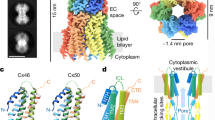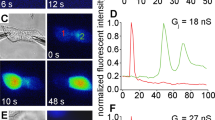Summary
The junctions connecting the epithelial cells of the human ciliary body were studied on replicas of freeze-fractured preparations. Gap junctions are present at the lateral surfaces of the cells of the pigmented epithelium. Gap junctions, isolated linear strands and desmosomes are found between the apical surfaces of pigmented and non-pigmented epithelial cells. Gap junctions, zonulae occludentes and desmosomes join the lateral surfaces of the non-pigmented epithelial cells.
These findings suggest that the blood-aqueous barrier is located at the level of the zonulae occludentes of the non-pigmented epithelial cells. This is consistent with previous studies using thin sections and tracer substances. The function of the many gap junctions connecting the cells of the two epithelial layers is obscure since their presence is not consistent with electrophysiological data from this region.
Zusammenfassung
Die Verbindungen zwischen den Epithelzellen des menschlichen Ciliarkörpers wurden mit Hilfe der Gefrierbrechungs-Methode untersucht. In den Abdrücken der lateralen Zellflächen des pigmentierten Epithels kommen “gap junctions” vor. Die apikalen Flächen der zwei aneinandergrenzenden Zellschichten zeigen “gap junctions”, vereinzelte Leisten und Desmosomen. Zwischen den lateralen Flächen der nichtpigmentierten Epithelzellen liegen “gap junctions”, Zonulae occludentes und Desmosomen.
Die Ergebnisse zeigen, daß sich die Schranke zwischen Blut und Kammerwasser im Bereich der Zonulae occludentes der nichtpigmentierten Zellschicht befindet. Dies bestätigt die Befunde, die andere Autoren an Dünnschnitten unter Anwendung von Tracer-Substanzen erhalten haben. Die Aufgabe der zahlreichen “gap junctions” zwischen pigmentierten und nichtpigmentierten Zellen ist unklar, da kein Einklang mit den vorliegenden elektrophysiologischen Befunden dieser Region besteht.
Similar content being viewed by others
References
Bennett, M. V. L.: Function of electrotonic junctions in embryonic and adult tissues. Fed. Proc.32, 65–75 (1973)
Berggreen, L.: Intracellular potential measurements from the ciliary processes of the rabbit eye in vivo and in vitro. Acta physiol. scand.48, 461–470 (1960)
Brightman, M. W., Reese, T. S.: Junctions between intimately apposed cell membranes in the vertebrate brain. J. Cell Biol.40, 648–677 (1969)
Chalcroft, J. P., Bullivant, S.: An interpretation of liver cell membrane and junction structure based on observation of freeze-fracture replicas of both sides of the fracture. J. Cell Biol.47, 49–60 (1970)
Claude, P., Goodenough, D. A.: Fracture faces of zonulae occludentes from “tight” and “leaky” epithelia. J. Cell Biol.58, 390–400 (1973)
Cole, D. F.: Electrical potential across the ciliary body observed in vitro. Brit. J. Ophthal.45, 641–653 (1961)
Davson, H.: The intraocular fluids. In: The eye, H. Davson, ed., vol.1, p. 67–186. New York-London: Academic Press 1969
Friend, D. S., Gilula, N. B.: Variations in tight and gap junctions in mammalian tissues. J. Cell Biol.53, 758–776 (1972)
Frömter, E., Diamond, J.: Route of passive ion permeation in epithelia. Nature (Lond.)235, 9–13 (1972)
Hogan, M. J., Alvarado, J. A., Weddell, J. E.: Histology of the human eye. An atlas and textbook. Philadelphia-London-Toronto: Saunders Co. 1971
Hudspeth, A. J., Yee, A. G.: The intercellular junctional complexes of retinal pigment epithelia. Invest. Ophthal.12, 354–365 (1973)
Kreutziger, G. O.: Freeze-etching of intercellular junctions of mouse liver. Proc. 26rh Ann. Meet. Electron Microscopical Soc. Amer., p. 234–235, C. J. Arceneaux, ed. Baton Rouge: Claitor's Publ. Div. 1968
McNutt, N. S., Weinstein, R. S.: The ultrastructure of the nexus. A correlated thin-section and freeze-cleave study. J. Cell Biol.47, 666–688 (1970)
McNutt, N. S., Weinstein, R. S.: Membrane ultrastructure at mammalian intercellular junctions. Progr. Biophys. molec. Biol.26, 45–101 (1973)
Miller, J. E., Constant, M. A.: The mesurement of rabbit ciliary epithelial potentials in vitro. Amer. J. Ophthal.50, 855–862 (1960)
Raviola, G.: Effects of paracentesis on the blood-aqueous barrier: an electron microscope study on Macaca mulatta using horseradish peroxidase as a tracer. Invest. Ophthal.13, 828–858 (1974)
Reale, E., Luciano, L., Spitznas, M.: Introduction to freeze-fracture method in retinal research. Albrecht v. Graefes Arch. Ophthal.192, 73–87 (1974)
Shabo, A. L., Maxwell, D. S.: The blood-aqueous barrier to tracer protein: a light and electron microscopic study of the primate ciliary process. Microvasc. Res.4, 142–158 (1972)
Shabo, A. L., Maxwell, D. S.: Electron microscopic localization of occluding junctions in the primate ciliary process and pars plana. Invest. Ophthal.12, 863–865 (1973a)
Shabo, A. L., Maxwell, D. S.: Structural organization of the pars plana-ora serrata transition in the human and monkey eye with emphasis on protein barriers. Lab. Invest.29, 511–526 (1973b)
Shiose, Y.: Electron microscopic studies on blood-retinal and blood-aqueous barriers. Jap. J. Ophthal.14, 73–87 (1970)
Smith, R. S.: Ultrastructural studies of the blood-aqueous barrier. I. Transport of an electrondense tracer in the iris and ciliary body of the mouse. Amer. J. Ophthal.71, 1066–1077 (1971)
Smith, R. S., Rudt, L. A.: Ultrastructural studies of the blood aqueous barrier. II. The barrier to horseradish peroxidase in primates. Amer. J. Ophthal.76, 937–947 (1973)
Staehelin, L. A.: Further observations on the fine structure of freeze-cleaved tight junctions. J. Cell Sci.13, 763–786 (1973)
Vegge, T.: An epithelial blood-aqueous barrier to horseradish peroxidase in the ciliary processes of the vervet monkey (Cercopithecus aethiops). Z. Zellforsch.114, 309–320 (1971)
Author information
Authors and Affiliations
Rights and permissions
About this article
Cite this article
Reale, E., Spitznas, M. Freeze-fracture analysis of junctional complexes in human ciliary epithelia. Albrecht v Graefes Arch. klin. exp. Ophthal. 195, 1–16 (1975). https://doi.org/10.1007/BF02390025
Received:
Issue Date:
DOI: https://doi.org/10.1007/BF02390025




